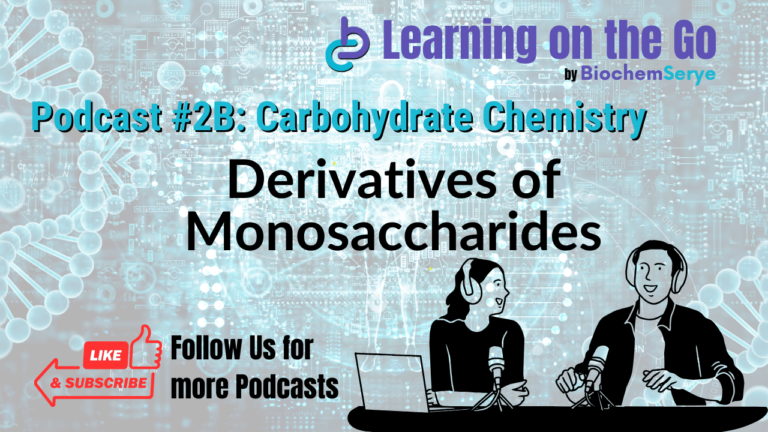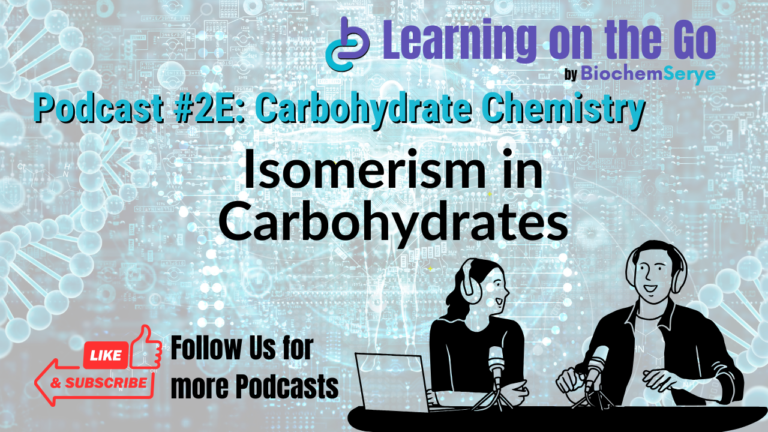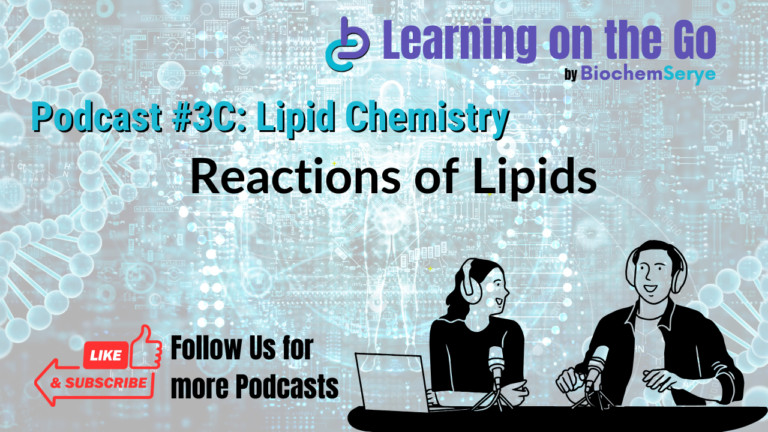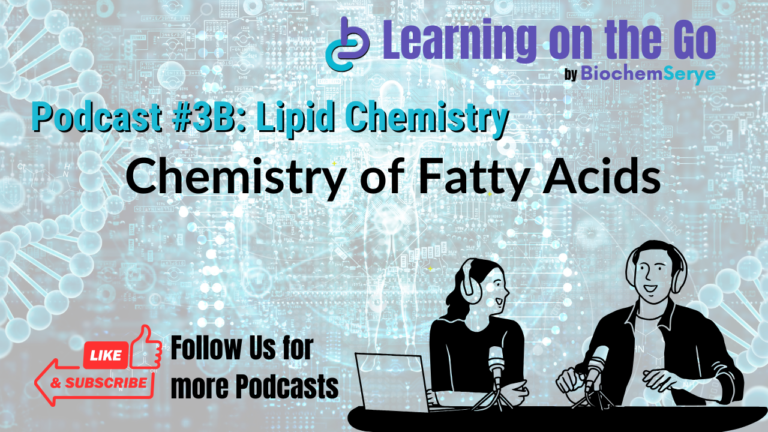Chemistry of Polysaccharides Biochemistry Notes
Chemistry of Polysaccharides Biochemistry Notes Outline
Chemistry of Polysaccharides: Structure, Function, and Clinical Significance
Polysaccharides, or glycans, are carbohydrates composed of ten or more monosaccharide units or their derivatives. Glycosidic linkages join these units. Polysaccharides are classified into two main groups: homopolysaccharides and heteropolysaccharides.

Chemistry of Polysaccharides: Homopolysaccharides (Homoglycans)
Homopolysaccharides are made up of several units of the same type of monosaccharide.
- Starch: This is the storage form of glucose in plants. It consists of two components:
- Amylose: A linear polymer of D-glucose units linked by α-1→4 glycosidic linkages.

- Amylopectin: Structurally similar to amylose with α-1→4 glycosidic linkages, but also contains side chains linked by α-1→6 linkages. It is a branched polymer, with branch points occurring every 20 to 30 glucose units.

- Glycogen: This is the major storage form of carbohydrate (glucose) in animals. It is often referred to as animal starch. Its structure is similar to amylopectin but more highly branched, with α-1→6 linkages occurring every 8 to 10 glucose units. Muscle glycogen is a readily available source of glucose for energy within the muscle, while liver glycogen is involved in storing and maintaining blood glucose levels.

- Cellulose: This is the chief component of plant cell walls. It is an unbranched polymer of glucose with long, straight chains linked by β-1→4 glycosidic linkages. Humans cannot digest cellulose because they lack the enzyme cellulase, but it is an important source of dietary fiber. High fiber diets are associated with reduced incidence of cardiovascular disease, colon cancer, diabetes, and diverticulosis. Cellulose also increases stool bulk, aids in intestinal motility, acts as a stool softener, and helps prevent constipation.

- Inulin: This is a polymer of D-fructose linked by β-1→2 glycosidic linkages. It is found in the tubers of some plants. It is not hydrolyzed by α-amylase, and humans do not have the enzyme inulinase to break it down for food. Clinically, inulin is used for glomerular filtration rate studies in kidney function tests.
- Dextrin: These are substances produced by partial hydrolysis of starch by acids or α-amylase. They have few free aldehyde groups and show a mild reducing property, but are not fermented by yeast.
Chemistry of Polysaccharides: Heteropolysaccharides (Heteroglycans)
Heteropolysaccharides contain two or more different types of monosaccharide units or their derivatives.
- Glycosaminoglycans (GAGs), also known as mucopolysaccharides, are unbranched heteropolysaccharides made up of repeating disaccharide units. One component of the disaccharide is always an amino sugar, either D-glucosamine or D-galactosamine. The other component is usually a uronic acid, such as L-glucuronic acid or its epimer L-iduronic acid. GAGs are often attached to extracellular proteins called core proteins (except for hyaluronic acid) to form proteoglycans. Proteoglycans can associate with hyaluronic acid to form proteoglycan aggregates.

- Functions of GAGs:
- Major components of the extracellular matrix provide a gel-like matrix for cushioning against mechanical shocks.
- They act as “molecular sieves,” controlling which substances enter and leave cells.
- They provide resilience to cartilage, allowing compression and re-expansion.
- They lubricate joints and mucous secretions.
- Types of GAGs:
- Hyaluronic acid: Serves as a lubricant and shock absorber and facilitates cell migration in processes like embryogenesis, morphogenesis, and wound healing.
- Chondroitin sulfate: Provides an endoskeleton structure to help maintain shape and plays a role in cartilage compressibility.
- Keratan sulfate: Important for the transparency of the cornea.
- Dermatan sulfate: Maintains the cornea’s transparency and the eye’s overall shape.
- Heparin: Acts as an anticoagulant and causes the release of lipoprotein lipase from capillary walls.
- Heparan sulfate: Found in the plasma membrane, where it may act as a receptor and participate in cell growth and cell-to-cell communication.
- GAGs differ from each other in the following properties: uronic acid composition; amino sugar composition; linkage between amino sugar and uronic acid; chain length of the disaccharide polymer; presence or absence of sulfate groups and their position; nature of the core protein; and tissue/subcellular distribution and biological function.
Chemistry of Polysaccharides: Clinical Significance
- Cellulose: Important as dietary fiber, it aids in digestion and helps reduce the risk of certain diseases.
- Inulin: Used to study glomerular filtration rates for kidney function tests.
- Glycosaminoglycans: Major components of the extracellular matrix play roles in lubrication, shock absorption, cell signaling, and tissue structure.
- Heparin: A GAG used clinically as an anticoagulant.
Glycoproteins
- While not polysaccharides, glycoproteins are proteins with covalently attached oligosaccharides. They contain less than 4% carbohydrate, unlike proteoglycans, which include more than 4% carbohydrate.
- Functions of Glycoproteins:
- Most plasma proteins are glycoproteins (except albumin).
- Many integral membrane proteins are glycoproteins.
- Secreted proteins like antibodies, hormones, and coagulation factors are glycoproteins.
- Serve as lubricants and protective agents (e.g., mucin).
- Serve as transport molecules (e.g., transferrin and ceruloplasmin).
Chemistry of Polysaccharides Frequently Asked Questions
Describe the key structural difference between amylose and amylopectin.
Amylose is a linear chain of glucose molecules linked by α-1→4 glycosidic bonds, whereas amylopectin is a branched chain with α-1→4 linkages in the main chain and α-1→6 linkages at branch points.
How does the function of muscle glycogen differ from that of liver glycogen?
Muscle glycogen serves as an immediate energy source for muscle cells, while liver glycogen stores and maintains blood glucose levels for the rest of the body.
Why can humans not digest cellulose? What nutritional benefit does cellulose provide despite not being digestible?
Humans lack the enzyme cellulase that can hydrolyze the β-1→4 glycosidic bonds in cellulose. Although indigestible, cellulose functions as dietary fiber, aiding digestion and promoting gut health.
What two main types of monosaccharide units are found in glycosaminoglycans (GAGs)? Briefly explain the general structure of GAGs.
GAGs are made of repeating disaccharide units. One component is always an amino sugar (D-glucosamine or D-galactosamine), while the other is a uronic acid (L-glucuronic acid or L-iduronic acid).
What are proteoglycans, and what is their general structure?
Proteoglycans are structures composed of a core protein with covalently attached GAGs, and they often form a “bottle brush” structure. These monomers can associate with hyaluronic acid and link proteins to larger aggregates.
Besides the presence of a core protein, what is the primary structural difference between proteoglycans and glycoproteins?
Proteoglycans have a significantly higher percentage of carbohydrates (greater than 4% of total weight) than glycoproteins (less than 4%).
Name three biological functions of GAGs in the body and provide a specific GAG example for each function.
GAGs provide shock absorption and lubrication (e.g., hyaluronic acid in joints), act as “molecular sieves” (e.g., heparan sulfate in cell membranes), and provide resilience to cartilage (e.g., chondroitin sulfate).
What role does inulin play clinically?
Inulin is used to study glomerular filtration rates (GFR), a kidney function test.
What are the key structural differences between sucrose, lactose, and isomaltose?
Sucrose comprises glucose and fructose linked by an α-1,β-2 bond with no free anomeric carbon. Lactose consists of galactose and glucose linked by a β-1→4 bond with a free anomeric carbon. Isomaltose is composed of two glucose molecules linked by α-1→6 bond.
How do the glycosidic linkages in cellulose differ from those in starch?
Cellulose is composed of glucose molecules linked by β-1→4 glycosidic linkages, whereas starch is made of glucose molecules linked by α-1→4 glycosidic linkages (amylose) and α-1→6 linkages (amylopectin).
Chemistry of Polysaccharides Glossary of Terms
- Amylopectin: A branched-chain homopolysaccharide form of starch composed of glucose units linked by α-1→4 glycosidic bonds with α-1→6 branches.
- Amylose: A linear chain homopolysaccharide form of starch composed of glucose units linked by α-1→4 glycosidic bonds.
- Cellulose: A linear, unbranched homopolysaccharide composed of glucose units linked by β-1→4 glycosidic bonds, a major structural component of plant cell walls.
- Chondroitin sulfate: A GAG that provides an endoskeleton structure and aids in cartilage compressibility.
- Dermatan sulfate: A GAG that contributes to corneal transparency and maintenance of the shape of the eye.
- Dextrin: A product of the partial hydrolysis of starch, containing a few free aldehyde groups.
- Disaccharide: A carbohydrate composed of two monosaccharide units linked by a glycosidic bond, e.g., lactose, sucrose, isomaltose.
- Galactose: A monosaccharide sugar, an epimer of glucose.
- Glucosamine: An amino sugar, a component of GAGs.
- Glucose: A monosaccharide sugar that serves as a primary energy source for cells; a component of many carbohydrates.
- Glycan: Another term for polysaccharide.
- Glycogen: A highly branched homopolysaccharide storage form of glucose found in animals, similar to amylopectin but more branched.
- Glycosaminoglycan (GAG): A heteropolysaccharide composed of repeating disaccharide units, with one component always an amino sugar; also known as mucopolysaccharides.
- Glycosidic bond: The covalent bond formed between two monosaccharides through a dehydration reaction.
- Glycoprotein: A protein with covalently attached oligosaccharides (less than 4% carbohydrate content).
- Heparan sulfate: A GAG found in cell membranes, playing roles in cell growth and cell-to-cell communication.
- Heparin: A GAG that acts as an anticoagulant and causes the release of lipoprotein lipase from capillary walls.
- Heteropolysaccharide: A polysaccharide composed of two or more different types of monosaccharide units or their derivatives.
- Homopolysaccharide: A polysaccharide composed of one type of monosaccharide unit.
- Hyaluronic acid: A GAG that is a lubricant and shock absorber, facilitating cell migration during embryogenesis, morphogenesis, and wound healing.
- Inulin: A polymer of D-fructose linked by β-1→2 glycosidic linkages found in plant tubers. Clinically crucial for kidney function tests.
- Isomaltose: A disaccharide composed of two glucose molecules linked by an α-1→6 bond.
- Keratan sulfate: A GAG that contributes to the transparency of the cornea.
- Lactose: A disaccharide composed of galactose and glucose linked by a β-1→4 glycosidic bond found in milk.
- Monosaccharide: A simple sugar; the basic building block of carbohydrates, e.g., glucose, fructose, galactose.
- Mucopolysaccharide: Another term for glycosaminoglycan.
- Oligosaccharide: A carbohydrate consisting of a few (typically 3-10) monosaccharides linked together.
- Polysaccharide: A carbohydrate composed of ten or more monosaccharide units linked together by glycosidic bonds; also known as a glycan.
- Proteoglycan: A macromolecule composed of a core protein with covalently attached GAGs, often in a “bottle brush” structure.
- Sucrose: A disaccharide composed of glucose and fructose linked by an α-1,β-2 glycosidic bond.








